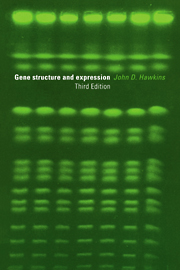Book contents
- Frontmatter
- Contents
- Introduction to the third edition
- Introduction to the second edition
- Introduction to the first edition
- List of abbreviations
- 1 Deoxyribonucleic acid (DNA)
- 2 Ribonucleic acid (RNA)
- 3 Methodology
- 4 Prokaryotic DNA replication and gene expression
- 5 The operon concept
- 6 Eukaryotic gene organisation and replication
- 7 Eukaryotic transcription
- 8 Post-transcriptional processing of RNA
- 9 Oncogenes
- 10 Haemoglobin
- 11 Proteins of the immune system
- 12 Some gene families
- 13 Mitochondrial and chloroplast genomes
- 14 Different and evolving genomes
- Glossary
- Reading lists
- Index
6 - Eukaryotic gene organisation and replication
Published online by Cambridge University Press: 05 June 2012
- Frontmatter
- Contents
- Introduction to the third edition
- Introduction to the second edition
- Introduction to the first edition
- List of abbreviations
- 1 Deoxyribonucleic acid (DNA)
- 2 Ribonucleic acid (RNA)
- 3 Methodology
- 4 Prokaryotic DNA replication and gene expression
- 5 The operon concept
- 6 Eukaryotic gene organisation and replication
- 7 Eukaryotic transcription
- 8 Post-transcriptional processing of RNA
- 9 Oncogenes
- 10 Haemoglobin
- 11 Proteins of the immune system
- 12 Some gene families
- 13 Mitochondrial and chloroplast genomes
- 14 Different and evolving genomes
- Glossary
- Reading lists
- Index
Summary
DNA is in the nucleus in discrete linear chromosomes, associated with proteins
Eukaryotic cells are distinguished from those of prokaryotes by possessing a nucleus, separated from the rest of the cell by a membrane, and containing the cell's genetic material. There is also a small amount of DNA in the mitochondria, discussed in Chapter 13. Nuclear DNA is organised in linear chromosomes rather than in a single circular one. The number and size of chromosomes varies considerably from one species to another (Table 1.1). There is a limited correlation between the total DNA content of a species and its evolutionary position. Many higher plants, amphibia and fish have a larger genome than humans and other mammals.
The nuclear DNA of eukaryotes exists as chromatin, associated with a number of proteins that are only found in the nucleus. The best known are the five major classes of histones (Table 6.1), which are among the most abundant cellular proteins. They are comparatively small proteins with an excess of positively charged amino acids (arginine and lysine) over the negatively charged ones. They are ideally suited for binding to negatively charged nucleic acids by multiple ionic interactions. Spermatozoa are exceptional in containing protamines, a group of even smaller highly positively charged proteins, in place of histones. They presumably aid in packaging the DNA into the small volume of the head of the sperm.
- Type
- Chapter
- Information
- Gene Structure and Expression , pp. 86 - 94Publisher: Cambridge University PressPrint publication year: 1996



